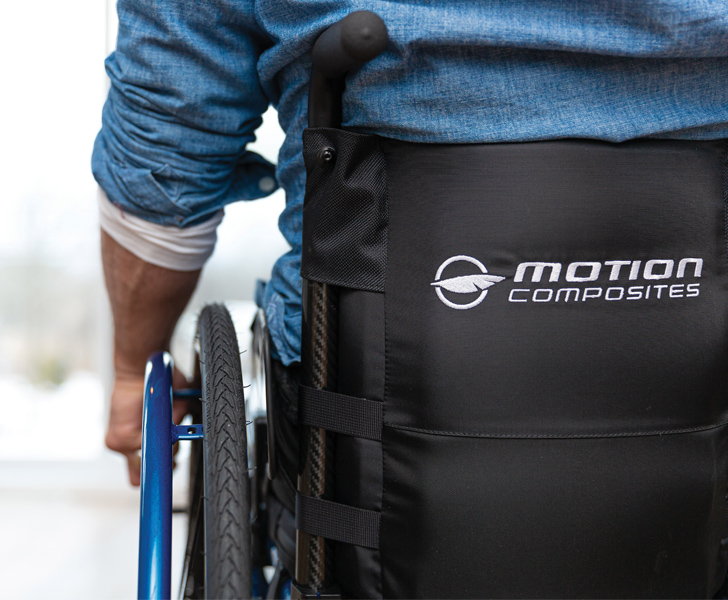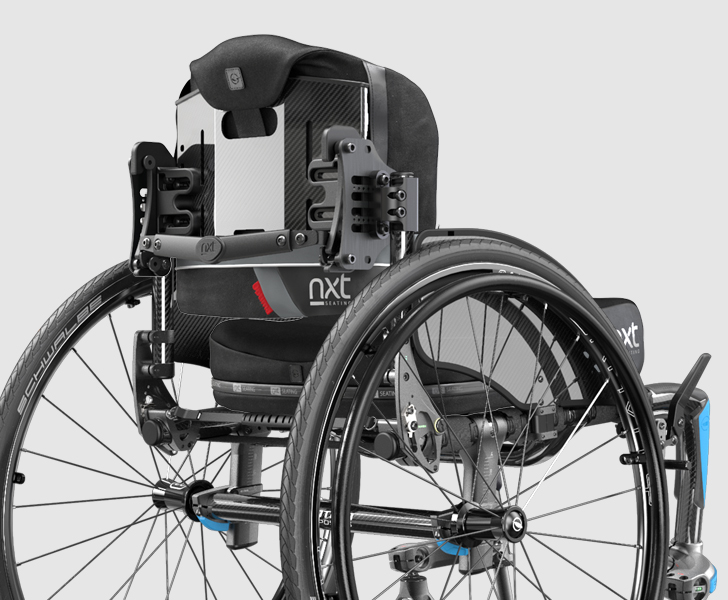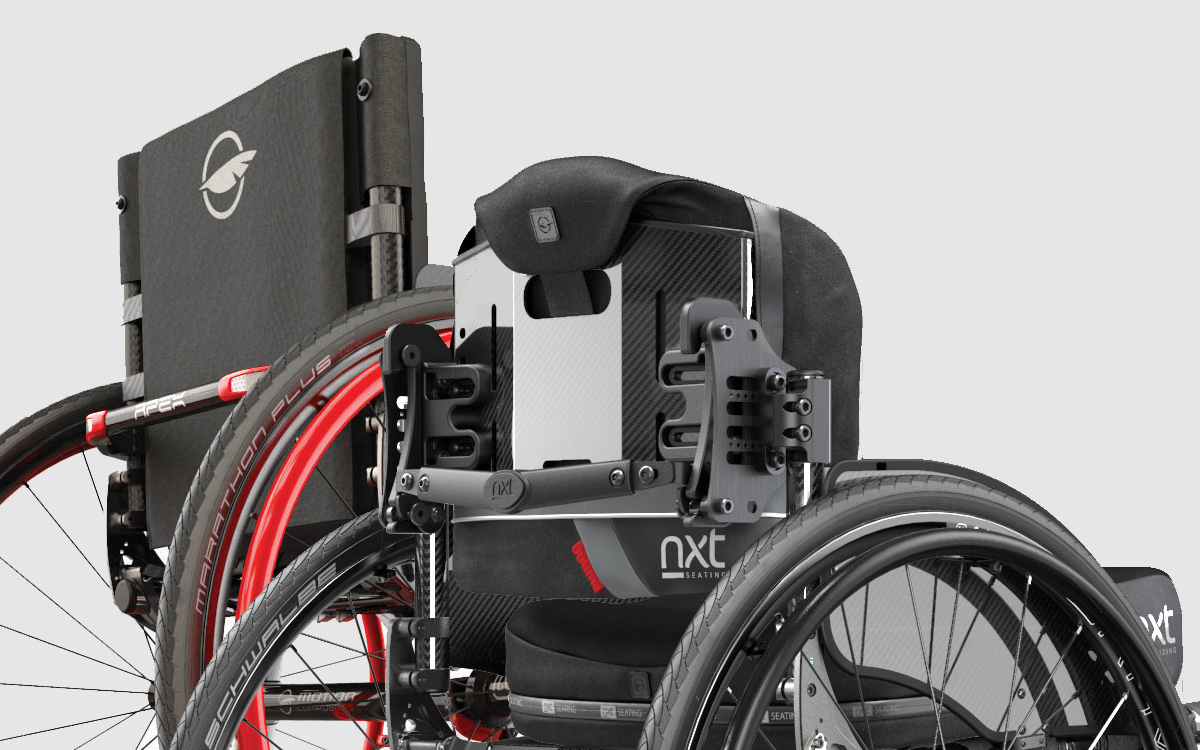Solid vs Upholstery Backs
A proper wheelchair evaluation should include justification for the type of wheelchair, accessories, and appropriate seating. Proper seating includes not only the cushion but also the chosen back support.
A proper wheelchair evaluation should include justification for the type of wheelchair, accessories, and appropriate seating. Proper seating includes not only the cushion but also the chosen back support.
When you initially think of the seating system, you may consider the cushion the foundation for good sitting posture. However, the choice of back support is also essential for pelvic positioning, as it enables the user to maintain a functional and safe position throughout the day. An upholstery-style back support is often the “standard” for an ultralight wheelchair, so today, we want to compare it with the solid back support alternative.

An upholstered back support is commonly found on a folding frame, as it is easy to fold the wheelchair for storage and transport. However, upholstery is also the standard back support option on a rigid frame wheelchair. This begs the question: "Is an upholstered back support the best clinical decision for my client in any ultralight wheelchair?" With the pros and cons listed below, you will be better equipped to choose the most appropriate for each situation.
| Upholstery/Sling Style |
Solid/Rigid Style |
|
Standard on wheelchairs |
Alternative to standard upholstery |
|
Flexible material, wearable over time |
Superior support for pelvis |
|
Conforms to client’s back |
Improved posterior support for trunk |
|
Promotes kyphotic posture |
Trunk stability facilitates upper extremity function |
|
Promotes posterior pelvic tilt |
Improved support for postural asymmetries and may prevent worsening of conditions |
|
Promotes long term postural asymmetries |
Potential folding frame disadvantage
|
|
Does not require removal when installed on folding frames |
Potentially the most important factor when deciding which option is best is to consider the ideal sitting posture. Posture and spine health starts with proper pelvic positioning. With any seating system, one clinical goal is to avoid a posterior pelvic tilt that can cause the client to slide toward the edge of the wheelchair. Maintaining a neutral or even slightly anteriorly tilted pelvis is ideal. A solid back support that captures the PSIS landmarks can help support the pelvis in this ideal position.
Keep in mind that the back support, along with an appropriate cushion and configuration of a manual wheelchair, creates the ideal positioning for both function, stability, and propulsion efficiency. Poor positioning over time can lead to injuries, such as shoulder impingement, back pain, or even abandonment of the wheelchair altogether if it does not meet the clients needs.
Without proper positioning, the client is at risk for increasing kyphosis of the thoracic spine, which in turn makes all functional tasks from the wheelchair, including propulsion, much more difficult. Even with the addition of tension adjustable straps, inherently, the upholstery will stretch over time, which only fosters an environment where the spine is unsupported and is at high risk for deformities. Especially for those patients who are already beginning to exhibit kyphotic, forward head posture – positioning is even more important to avoid further deformity and any subsequent comorbidities.
Another common outcome of poor positioning over time is upper extremity injuries, ranging from issues at the carpal tunnel in the wrist to impingement or soft tissue injury at the shoulder joint or scapula. To an independent propeller, their upper extremities become their engine for propulsion and every single daily task, making static and dynamic positioning of the pelvis, spine, and, ultimately, the upper extremities extremely important. Upper extremity health is important for propulsion, but maybe even more so for everyday tasks and activities. A severe upper extremity injury can lead to the need for dependent mobility, the potential to stay in bed while healing, and poor quality of life. You may have heard the phrase “upper extremity preservation” when learning about manual wheelchair prescription. It is crucial that the justification for seating components, the manual wheelchair, and accessories reflect the gravity that the statement holds.
The solid back argument is easily won when dealing with a rigid frame wheelchair. But for all the reasons above, they should also be strongly considered for those clients in a folding frame wheelchair. The reason clients are placed in an ultralight wheelchair is to access their environment independently and efficiently while avoiding upper extremity injury. If their situation allows, a rigid back support is known to be a better solution for independence and efficiency.

Do you have many clients who foot propel? Proper pelvic positioning could be even more important in those situations. The hamstrings are extensively utilized in foot propulsion, which will repeatedly pull the pelvis into a posterior tilt if not properly supported by both a back support and cushion.
In a study recently completed by Presperin Pederson et al., 2020, the researchers wanted to demonstrate that propulsion efficiency is also improved when using a solid back support over an upholstery style that does not support the spinal curves. The study found that all the measures below improved with solid back support:
- Posture
- Function [reaching and propulsion]
- Pain (Visual Analog Scale)
- Satisfaction Survey [stability, comfort, upholstery vs. solid preference, pelvic positioning, ease of daily activities/life]
One of the most clinically relevant measures in terms of the client was that each participant reported that their confidence improved when maneuvering using a solid back support. We objectively see this in the study by the posture measurements improving with the solid back support. With proximal stability, you get distal ability! To have more confidence means a better quality of life for our clients. Next time you decide between a solid or an upholstery back, educate the client, weigh the pros and cons, and help the client make a better decision for their individual preference.
